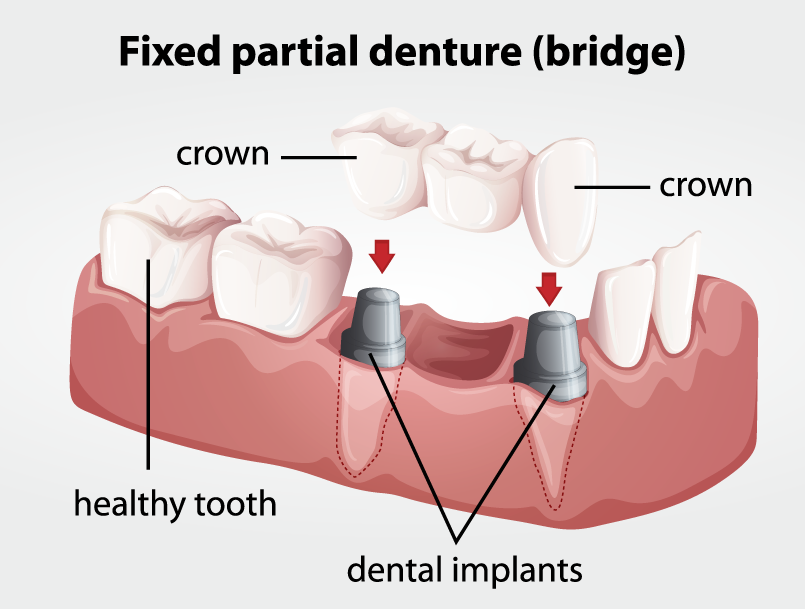Why You Need Bridges for Missing Teeth?
Missing teeth can lead to various issues, including oral structure deterioration, compromised function, and discomfort. The gaps left by missing teeth can cause neighboring natural teeth to shift, affecting bite alignment, facial appearance, and speech. To address this, your dentist may recommend oral bridges as a solution to replace missing teeth. Dental bridges can be either removable or permanent, providing essential benefits for your oral health and well-being.

Understanding Dental Bridges
Dental bridges serve as a reliable tooth replacement option for one or more missing teeth. They not only restore the aesthetics of your smile but also improve chewing and speaking abilities. Your dentist will create a dental bridge by taking an impression of your mouth and sending it to a dental lab, where the bridge is custom-made. Depending on the materials used, the process typically takes two weeks to several months to complete.
Permanent or Removable: Types of Dental Bridges
Permanent Dental Bridges
Traditional dental bridges are typically permanent solutions for tooth replacement. They require regular checkups to ensure the strength and health of the teeth supporting the bridge. Fixed bridges are securely attached using dental cement, providing long-lasting stability and functionality.
Removable Dental Bridges
Removable oral bridges, also known as partial dentures, can be easily removed for cleaning and during the night. They consist of artificial teeth attached to a gum-colored plastic base. The removable bridge connects to dental implants or natural teeth using small attachments. This option is suitable if you still have some natural teeth remaining.
Cost Comparison: Dental Bridges and Implants
When comparing the cost of oral bridges and implants, bridges are generally more cost-effective, especially when replacing multiple teeth. Dental implants may require additional procedures like bone grafts or sinus lifts, increasing the overall cost.
Pain-Free Preparation
Preparing your teeth for a dental bridge is a painless procedure, as local anesthesia is used during the process. After the treatment, minimal discomfort is expected, and pain medication is rarely required.
Ready to book your appointment at Dentist in Louisville?
Debunking Myths: Bridge Stability and Longevity
Myth: Bridges fall out easily. Fact: Contrary to common misconceptions, oral bridges are not flimsy and can last a lifetime with proper care. Although they may loosen over time, your dentist can easily adjust them. Practicing good oral hygiene significantly reduces the chances of your bridge becoming loose or falling out.
Say Goodbye to Tooth Gaps!
Advantages of Dental Bridges
A dental bridge restores the appearance and function of your teeth by closing the gap caused by missing teeth. The bridge consists of false teeth (pontics) supported by crowns attached to adjacent natural teeth (abutment teeth). This restoration offers the following benefits:
- Restored smile and facial appearance
- Improved ability to chew and speak
- Maintenance of facial shape
- Proper distribution of bite force
- Prevention of remaining tooth movement

Different Types of Dental Bridges
- Traditional Bridges: The most common type, made of porcelain fused to metal or ceramic, supported by crowns on abutment teeth.
- Cantilever Bridges: Less commonly used, typically avoided for back teeth due to uneven biting forces. Used when only one side of the gap has abutment teeth.
- Maryland Bonded Bridges: These bridges have “wings” made of metal or porcelain bonded to abutment teeth. They can be made of porcelain, porcelain fused to metal, or plastic teeth and gums supported by a metal or porcelain framework.
The Dental Bridge Procedure
To receive a dental bridge, you will need at least two visits to your dentist:
First Visit:
- Preparation of abutment teeth by reducing their size and contouring.
- Impressions of your teeth are taken to create custom-made dental bridges.
- Temporary bridge placement to protect the prepared abutment teeth while waiting for the permanent bridge to be ready.
Second Visit:
- Removal of the temporary bridge and placement of the permanent bridge.
- Adjustment of the bridge for proper fit and comfort.
- Temporary cementing of the bridge, followed by subsequent visits to ensure a secure fit.
- Final cementation of the bridge once it is fully adjusted and functioning as intended.
Aftercare for Dental Bridges
It may take some time to adjust to a dental bridge when eating and speaking. However, with practice, these tasks will become comfortable and natural. Proper care and maintenance can extend the lifespan of your dental bridge. Follow these guidelines:
- Practice good oral hygiene, including regular brushing and flossing.
- Schedule regular dental examinations and cleanings to ensure the bridge’s longevity.
- Notify your dentist of any discomfort, looseness, or changes in fit.
By following these recommendations, your well-maintained dental bridge can last up to fifteen years or longer, allowing you to enjoy a confident smile and optimal oral function.
For more information about dental bridges, Contact your Dentist in Louisville.








